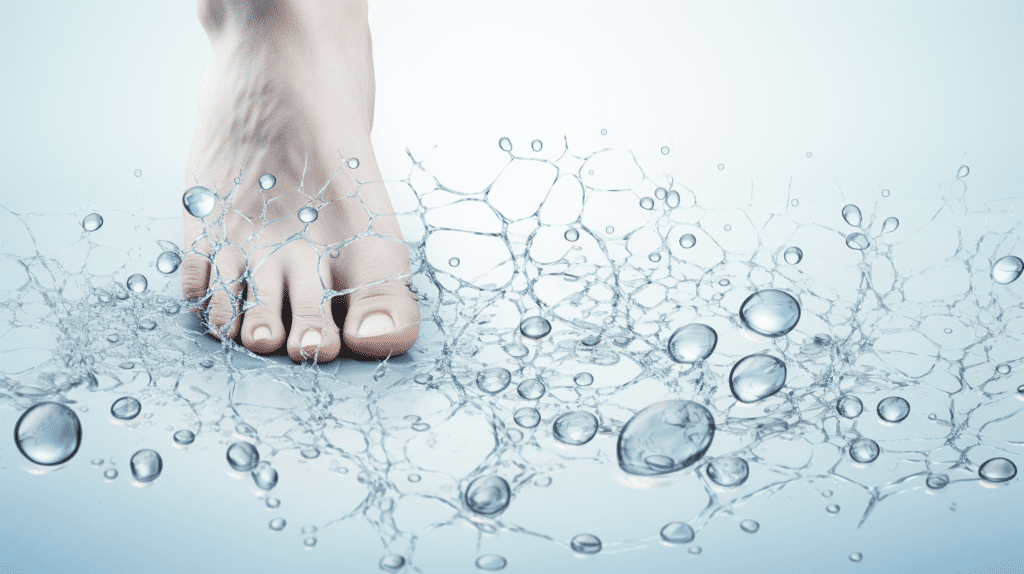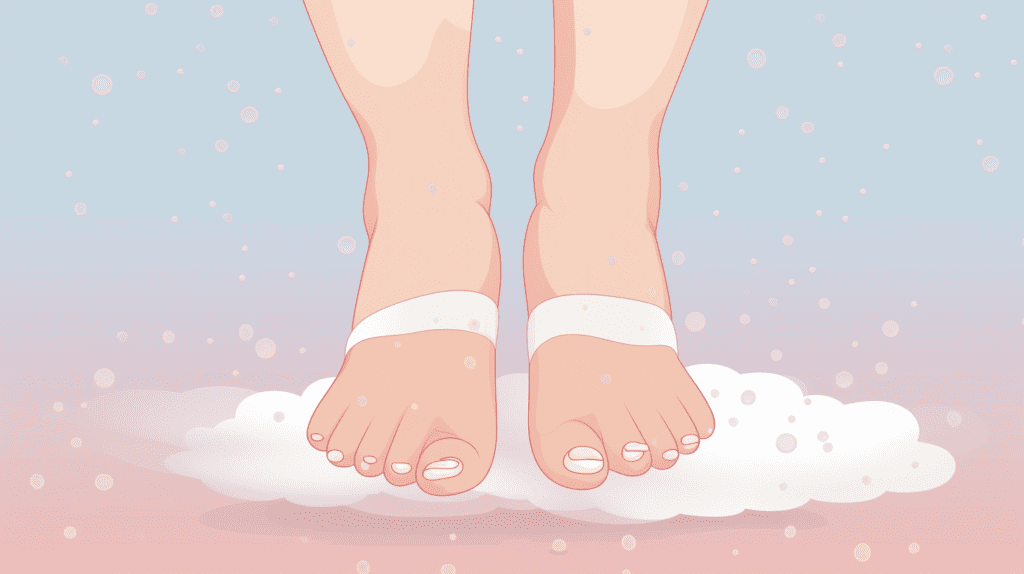Introduction:
As someone with over five years of experience in podiatry research, I’m passionate about helping others keep their feet healthy and stylish year-round. Unfortunately dry skin on your feet can be an annoying reality – but that doesn’t mean you have to give up on your quest for smooth soles and toes! Dryness discomfort is caused by an imbalance between natural levels of oils in our skin resulting in excessive moisture loss from the body, leading to cracked heels.
This makes it hard to know which methods work best when treating this condition. Fortunately, I’m here with tips based off my experience so you don’t have to sacrifice health or fashion while keeping those toes soft all year long.
Read further for top advice on how to treat dry skin on your feet!
Key Takeaways
- Hydrating the body and using specifically formulated ointments or creams for dry skin on feet are crucial in keeping feet smooth and healthy year round.
- Exfoliating regularly with pumice stone, scrubbers or foot filers can help reduce flaking, itchiness and tenderness due to dead skin cells build up.
- Avoiding harsh soaps or deodorants as well as hot showers is essential to prevent further drying out of feet while applying thick moisturizers such as oils, creams etc before bedtime locks in hydration all night long.
- Wearing socks when going to sleep at night will keep your feet warm while adding a layer of protection against excessive moisture loss from the body
What Causes Dry Skin on Feet?

Dehydration, xerosis or other health conditions can result in dry, cracked skin on the feet.
Dehydration
Dehydration is a significant cause of dry skin on feet. When our bodies don’t get enough water, it can lead to a loss of moisture and elasticity in the skin. This can lead to stiffness and itchiness along with an overall tone and complexion that appears dull or uneven.
Everyday things like using deodorant soaps or harsh cleaning products often strip away the natural oils on your feet, leading them to become dry more quickly than normal. Medications such as diuretics, antihistamines, and antidepressants may also contribute to dehydration by reducing the amount of oil needed for moisturizing the skin on your feet.
Staying hydrated is essential for protecting your body from developing dryness, especially when combined with other foot care measures like avoiding tight shoes that can block sweat glands doing their job and making sure you regularly exfoliate dead skin cells from between your toes!
Xerosis
Xerosis, also known as dry skin, is a common skin condition characterized by roughness and scaling of the skin. It occurs when there is insufficient hydrolipids in the stratum corneum—the outermost layer of the skin—which results in disruption to its natural barrier function and/or lack of moisturizing factors.
Some environmental factors can contribute significantly to dry feet such as spending too much time in chlorinated water or hot showers, using harsh soaps or deodorants with alcohol content, excessive rubbing of towel on wet limbs, irregular moisturizing habits or any other factors which strip moisture from the feet.
Symptoms may include flaky buildup on the soles and between toes due to dead cells sticking together, lips forming around edges where two surfaces meet like heels or sides of feet; itchy red patches due to accumulation of trigger substances at certain points; discomfort while walking owing to hardened skin along with cracks; feeling tightness after washing despite having put moisturizer earlier etc. If left untreated for long enough duration then fungal infection might occur leading further complications if not taken care off immediately with evidence-based treatments.
Other health conditions
Many health conditions can lead to excessive dry skin on the feet, including diabetes, thyroid disease, and kidney problems. Diabetes is a complex metabolic disorder which causes glucose (sugar) levels in the blood to spike higher than normal.
Over time, this may contribute to excessively dry skin on the feet via changes in circulation or neuropathy (nerve damage). Similarly, diseases of the thyroid gland such as Hashimoto’s and Graves’ Disease can also affect hormones levels that influence moisture retention in the feet.
Lastly, certain kidney diseases like nephrotic syndrome can cause abnormalities in protein metabolism leading to excess flaking and peeling of skin on the entire body – even when fats/lipids typically found within those proteins are already being replenished by medical treatments or nutrition therapy.
Top Tips to Treat Dry Skin on Feet
Keeping your feet hydrated, exfoliating regularly, wearing socks to bed and applying moisturizer daily are some of the best ways to treat dry skin on your feet.
Increase water intake
Increasing water intake can be beneficial in maintaining healthy feet. Being dehydrated is a common cause of dry skin, and the importance of staying hydrated for overall good health cannot be underestimated.
Adequate water consumption helps to keep skin cells moist and promote natural exfoliation resulting in softer skins on our feet. A small pilot study conducted by researchers compared the effects of mineral versus regular water in regard to skin health, however more research is needed to confirm its findings.
Mineral water does contain minerals like magnesium or calcium which are beneficial nutrients when it comes to maintaining healthy skin, so they could have an influence on countering dryness and flaky patches too.
Exfoliate regularly
Regular exfoliation is essential to keeping dry, flaky skin on feet at bay. Exfoliating will help remove dead skin cells that can accumulate and result in a rough surface texture. It is important to use the best tools for your needs such as pumice stone or foot scrubber.
Soaking your feet in warm water before exfoliating enables you to get rid of dead skin much easier than if you don’t. This also helps blood circulation, bringing fresh oxygenated blood which ensures healthy cell renewal process when combined with moisturizing and nourishing ingredients like shea butter, aloe vera etc., this results into toes being softer and smoother over time! Foot file and/or pumice stones are recommended as they work at deeper levels helping bring out dry patches right away! Don’t forget to pat your feet dry after soaking them; dampness encourages bacteria or fungal growth which could lead onto more serious problems like athlete’s foot.
Moisturize daily
Moisturizing is key for maintaining soft and healthy feet all year round. Spending just a few minutes each day moisturizing your feet can make a big difference when it comes to preventing dry, cracked skin.
Dermatologists recommend using ointments or creams instead of lotions to effectively treat and prevent dry skin on the feet as these have greater hydrating power. It’s important to avoid harsh soaps or hot water and moisturize throughout the day in order to keep your skin hydrated.
Using thick moisturizers such as foot creams, oils, or exfoliating scrubs before bedding can help protect your feet from further drying out while providing nourishment that will last overnight.
Use foot creams or oils
Foot creams and oils play an important role in treating and preventing dry skin on the feet. These products are specifically formulated to provide intense hydration that can penetrate deeply beneath the surface of the skin, achieving maximum softness.
Foot creams typically contain beeswax or shea butter to form a soothing protective barrier that locks moisture into the skin for long lasting softness. Additionally, foot oils are particularly beneficial for extra-dry feet as they instantly dissolve upon contact with the skin, hydrating from within while also leaving a layer of protection on top of the feet.
Coconut oil is especially rich in essential fatty acids and antioxidants—characteristics that make it hugely beneficial for moisturizing and nourishing super-dry patches on feet.
Wear socks to bed
Wearing socks to bed is a must for women who struggle with dry skin on their feet. Not only will it keep your feet warm, but they can also add a layer of protection and help retain moisture in the skin preventing further cracking and dryness.
Moisturizing the feet before putting on socks can also make sure that any lotion or cream applied stays in place all night long. When looking for suitable pairs of socks, choosing those made from natural fibers like cotton, wool or bamboo fabrics is recommended as they are softer and lighter than synthetic ones which don’t allow your feet to breathe.
In addition, you may want to look into special foot repair masks that nourish your skin overnight while keeping it safe inside cloth-lined pocketed slippers or booties!
Avoid harsh soaps and hot water
Using harsh soaps and hot water can strip the skin of its natural oils, leading to dryness and discomfort. They also dissolve fatty acids that make up vital components of our cellular membranes which help repair the minuscule damage done by everyday activities such as friction during walking or running.
Avoid using antibacterial soaps, fragrances, alcohol, or any other cleaning agents that can cause further drying out. Instead switch to a gentle cleanser like Dove, Olay, Basis or Cetaphil Skin Cleanser when washing your feet.
Additionally it is important to shower in lukewarm rather than hot water as this helps keep the moisture locked into the skin barrier helping to alleviate dryness and itching over time.
Visit a podiatrist if needed
When it comes to treating dry skin on the feet, a visit to a podiatrist can be very helpful. Our feet are complex structures that require special attention and care; any diabetic or circulatory problems may lead to severe foot complications without proper treatment.
To get the most out of your treatments for dry skin on the feet, consulting with a professional should be considered; they will evaluate your specific needs and provide you with guidance on how best to address them.
Additionally, they can prescribe medicated and natural anti-fungal, antimicrobial foot creams that effectively fight off infection while restoring moisture in cracked or scaly areas of the feet.
How to Exfoliate and Moisturize Dry Feet
Dry feet can benefit from weekly exfoliation to remove dead skin cells and create a smoother surface, as well as the regular use of moisturizing creams or oils to retain hydration.
Soaking in warm water can help soften dry patches before using a pumice stone or foot scrubber to gently slough away built-up layers of skin.
Soaking in warm water
Soaking your feet in warm water can be a great way to soften your dry skin and make it more manageable. Warm water helps open the pores of your feet, allowing moisturizers like lotions and oils to penetrate deeper into the skin for better hydration.
Depending on the condition of your dry skin, it’s best if you soak for 10-20 minutes at a temperature that’s comfortable but still allows some penetration of moisture into the deep layers of your skin.
You can also add essential oils or salts to augment its effectiveness as well—lavender essential oil is especially effective at soothing irritation associated with dryness while epsom salt helps exfoliate dead cells from the surface layer of dry or cracked skin for improved gentleness and suppleness afterward.
Using a pumice stone or foot scrubber
A pumice stone or foot scrubber can be an indispensable tool in managing dry, cracked feet. It has a coarse texture that helps slough off dead skin and soften hard, calloused areas on the feet.
Pumice stones are often used to remove corns and calluses from the bottom of the feet while exfoliating rough patches of dry skin. They can also help reduce buildup from lotions and other topical irritants like sweat.
To use a pumice stone effectively it’s important to first soak your feet in warm water which softens the skin for easier exfoliation without causing any harm to your foot. This method is recommended as its gentle but effective enough to slough away dead cells on all parts of your foot such as heels, toes, arches and soles while keeping them free from irritation; especially if you suffer from diabetic neuropathy soreness & pain due to neglected maintenance of foot care – this will ease discomfort significantly! After soaking up the moisture in warm water you would then lightly rub down with your chosen pumice stone or hairbrush-style pedicure file until you feel satisfied with removing any visible tough patches or lumps surfacing then rinse thoroughly with cold running tap water & apply Shea Butter immediately afterwards – leaving you feeling silky smooth & brand new!
Applying a thick moisturizer
before going to bed is an effective way of keeping the skin on your feet hydrated and healthy. For treating dryness and cracked heels, a good moisturizer should be applied directly onto clean, damp skin; this helps lock in moisture for lasting softness.
Petroleum jelly products such as Vaseline are particularly helpful for sealing in water on the soles of the feet while sleeping. When choosing a moisturizer, opt for thick creams or ointments, as these offer deeper penetration into skin layers than thin lotions do.
Additionally, a small amount of lanolin oil can help protect against future damage and dehydration from outside elements without leaving behind any greasy residue. To apply properly, slather it generously all over both feet then pop a pair of cotton socks over them before hopping into bed – voila! Having consistently soft baby-like feet has never been easier!
Best Cosmetics for Dry Skin on Feet
Choosing the right foot cream or oil can be key to achieving soft, healthy feet again. Look for products that contain shea butter, lactic acid, urea, jojoba oil and vitamin E as these ingredients may help in relieving dry skin and smoothing out rough surfaces on your feet.
Foot creams
Foot creams are a popular choice for treating dry skin on feet, and for good reason. Foot creams contain ingredients such as shea butter that help to soften and moisturize the skin, while healing cracked heels or other affected areas.
They are made with thicker bases than regular lotions so they coat your feet more effectively while nourishing them with vitamins, humectants, and antioxidants. A foot cream should be specially formulated for cracked feet in order to maximize its benefits; specifically look out for products with active ingredients like urea, ceramides, salicylic acid, aloe vera extract or glycerin.
It’s important to remember when using a foot cream to apply generously and evenly all over clean dry feet before bedtime then put on socks after applying the product. Doing this regularly can help restore softness of the skin on your feet whether you’re dealing with xerosis or another condition related to dry skin.
Oils
For women looking to give their feet a little extra TLC, oils are the perfect solution. Oils can provide intense moisture, nourishment and hydration with regular use. As well as being incredibly effective at treating existing dry skin on feet, they can also help to prevent further damage and keep your feet in tip-top shape all year round.
Natural crossorbotanicals like sweet almond oil, sunflower seed oil and apricot kernel oil have been used for centuries in skincare regimes due to their ability to soothe, soften and nourish the skin.
They contain essential fatty acids which help restore moisture balance while locking in long-lasting hydration – making them great options for those suffering from dryness of the feet.
Exfoliating scrubs
Exfoliating scrubs are an important part of any skin care routine. They help to remove dry and flaky skin cells on the surface of the feet without damaging healthy tissue underneath.
A regular exfoliation is especially beneficial if you have severely dry or cracked feet, as it can help to loosen dead skin that’s stuck in place and smooth rough surfaces. Exfoliants usually contain tiny particles like buffing beads, grains, nuts or seeds that gently slough away excess debris from the outermost layer of your feet.
Additionally, most exfoliant products also contain nourishing ingredients such as aloe vera, shea butter or oil which helps lock in moisture to keep your sensitive skin hydrated throughout the day.
Preventing Dry Skin on Feet

Practicing good hygiene habits and wearing proper footwear can help keep feet healthy and soft, so use these tips to stay comfortable year-round!
Keeping feet clean and dry
It is essential to keep one’s feet clean and dry in order to prevent the onset of dry skin. Cleansing should be done on a daily basis, with warm water using mild soaps such as those made for sensitive skin or low-residue body wash formula products.
Make sure that any sweat or moisture from activity are removed afterwards with gentle patting rather than rubbing. Dabbing the feet lightly with a towel can help further upon removal of excess liquid without aggravating the delicate foot area, it’s also important to avoid hot showers when cleaning the feet as this can strip away natural oils which play an important role in providing healthy hydration levels.
As well as removing dirt and bacteria effectively wearing shoes all day can lead to sweaty conditions that require careful management; changing socks frequently helping remove absorbed sweat during wear cycles helps promote good hygiene whilst avoiding trapped bacteria growing within areas where hydro environment exist.
Wearing comfortable shoes
Avoiding harsh or restrictive socks
When caring for your feet, it’s important to pay attention to the type of socks you wear. Tight and restrictive socks can decrease blood circulation by constricting movement. This reduces the skin’s exposure to oxygen-rich air, potentially leading to dryness and scaling—particularly on a person with sensitive or already compromised skin.
It’s also important not to purchase overly thick socks as they will reduce breathability, which can lead to an increase in moisture and perspiration occurring between toes; this too is a recipe for dry cracked feet.
The best route is always 100% cotton fabrics such as mercerized or combed cotton due their natural ability wick away excess perspiration but still allow the foot some breathing room within synthetic materials typically found in athletic footwear nowadays would often decrease the temperature of the foot as much as 3ºC helping prevent blister formation by limiting irritation and friction while doing physical activities.
Conclusion
In conclusion, keeping your feet healthy and free of dryness requires consistent maintenance. Taking proper care of your feet year-round is the best way to ensure that they are soft and moisturized.
Dry skin on feet can be caused by several factors such as dehydration, xerosis, health conditions or vitamin deficiencies. Regular exfoliation with pumice stone or foot scrubs along with regular moisturizing through thick creams or oils may help in preventing discomfort due to dry skin on feet.
Additionally, preventive measures like protecting them from extreme temperatures and moisture between the toes can also relieve symptoms associated with it. By following the tips provided in this blog post about treating, preventing & managing dry skin on feet throughout different seasons, one will be able to maintain natural beauty of their legs ensuring they look and feel great all year round!

